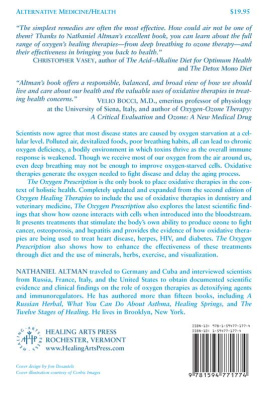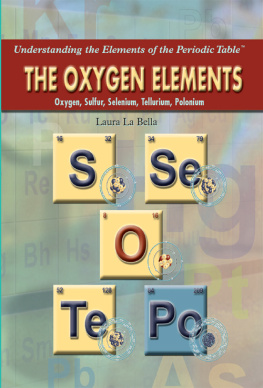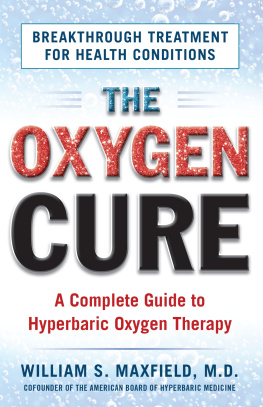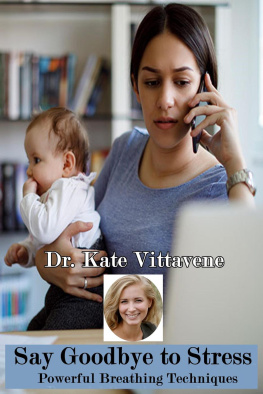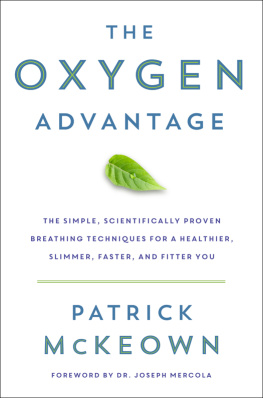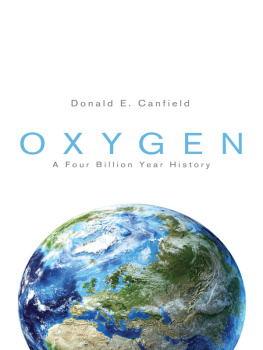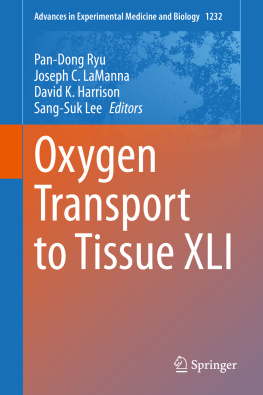
This book is dedicated to the memory of
Adelson de Barros.
DISCLAIMER
The author of this book is not a physician. The following material is presented in the spirit of historical, philosophical, and scientific inquiry and is not offered as medical advice, diagnosis, or treatment of any kind.
Although studies have attested to the safety of oxidative therapies at established therapeutic dose levels, it should be remembered that ozone and hydrogen peroxide are powerful oxidizers. They can be dangerous if not stored, handled, and utilized properly. Oxidizers like food-grade hydrogen peroxide should always be correctly labeled and kept out of reach of children. The author and publisher advise against self-treatment with oxidative therapies. Any medical treatment should be done under the supervision of a qualified health practitioner.
Foreword
I am glad that Nathaniel asked me to write a few words for his new book: he has been a pioneer in writing about oxygen and ozone therapy. In this third edition of Oxygen Healing Therapies, he includes all the available information without overemphasizing either results or practical implications.
He has proved to be a very precise journalist, retrieving and reporting a great number of studies, some of them unknown to me. It was a pleasure to read this latest edition, particularly those chapters dealing with nutrition and the powerful influence of our mind on our body.
Nathaniel has reported all the results of the laboratory and clinical studies that have been done on oxygen therapies, even though some data seem too good to be true. I know too well that owners of private clinics often want to sell gold for copper because of their personal interest. Both Nathaniel and I are convinced that boosting untruthful results is wrong, and we hope that the reader will discern the wheat from the chaff, because we do not want desperate patients to believe that ozone is a miraculous drug able to cure the very worst illnesses.
Biological and clinical experience acquired in the last fifteen years has taught me that, up to now, the pathology where ozonated autohemotherapy has a unique advantage is the dry-form of age-related macular degeneration. Even though distinguished ophthalmologists do not admit this, I can assure them that about two-thirds of patients (except those advanced cases whose photoreceptors are already dead) will notice an improvement of their visual acuity, enough to become self-sufficient and improve their overall quality of life. Orthodox ophthalmologists have no therapy, except the administration of antioxidants like lutein, which neither harm nor help the macular ischemia.
Other diseases such as vascular ischemias (limb and heart) improve markedly with autohemotherapy, particularly when used in conjunction with, when necessary, topical therapy with ozonated water and ozonated oil. In my experience, these treatments yield better results than the orthodox prostanoid infusions usually prescribed, without adverse side effects. A preparation of ozonated oil, which is the only way to stabilize ozone as a triozonide, displays marvelous disinfectant and stimulatory activities in chronic, purulent ulcers, bedsores, and other skin problems. When the benefits of ozonated oil become more widely known and accepted by the medical community, this treatment will become a valuable resource for millions of patients. However, in vascular pathologies (such as atherosclerosis, high blood pressure, and angina), I advise patients to also take advantage of the idoneous drugs (such as statins, antihypertensive, and anticoagulant drugs) provided by the medical establishment.
I would like to take the opportunity to remark upon the very intense and foolish antagonism between orthodox and complementary medicine over whether there is only one medicine or form of treatment that is able to restore a patients health. To claim that treatments such as ozone therapy, homeopathy, or acupuncture are better than conventional medicine because they are less toxic (but not necessarily cheaper) is incorrect and naive; common sense and experience tell us that it is better to select and take advantage of the most available and effective treatments. Physicians must be acquainted with all useful options and cannot behave like religious sectarians.
There are certainly other relevant pathologies, such as chronic bacterial, fungal, and viral infections, that can be treated proficiently and cured when we use an appropriate combination of ozone therapy along with antibiotics and/or antivirals. We have learned the hard way that attacking serious diseases with a combination of approaches is the winning strategy, because these diseases are always sustained by a variety of causes.
Do ozone therapy and oxidative therapy have some limits? They certainly have, and the patient must be better informed about them because they are not trivial. Owing to the chemical instability of ozone, selftreatment is not recommended. Patients should always go to a hospital or medical clinic for treatment. There is often the need for venipuncture and, particularly in women, venous access tends to deteriorate over time. Moreover, after a first therapeutic cycle, ozone therapy must be continued practically for life, even though a less frequent schedule is required.
Unfortunately, recent clinical papers claiming the superiority of ozone therapy in patients with a diabetic foot condition neither mention the need for follow-up treatments nor discuss the absolute need for continuing treatments for years. The papers only mentioned that the treatments were performed over three weeks with about fifteen rectal insufflations of gas versus antibiotic therapy.
My experience has taught me that ozone therapy does not improve diabetes in three weeks. In addition, rectal insufflation of gas, although safe, simple, and economical, is an imprecise and only modestly effective method. If a patient were to acquire an ozone generator, he or she might be able to perform the therapy at home under a physicians supervision, but this rarely happens because of the expense and limited availability of the necessary equipment. I have mentioned these drawbacks because we are hoping to soon find new, valid options that will overcome these limitations.
The beauty of ozone is that when this molecule, almost as old as primordial life, is applied in small and precise doses, it is able to simultaneously trigger or reactivate many functional activities that have gone astray during a chronic disease. Among complementary medical approaches, ozone therapy is the only one where the chemistry, the mechanisms of action, and the biological effects (hence the therapeutic effects) have been delineated well enough to be considered a scientifically based discipline. From a neurophysiological point of view, acupuncture has also reached a similar stage of scientifically documented effectiveness. By contrast, homeopathy remains undefined, perhaps because we do not yet have the appropriate technology to demonstrate the pharmacological effect, if any, transmitted by water.
I am still fighting with some chemists who state that ozone is always toxic and should not be used in medicine. Their opinion is based on a lack of understanding about biology and medicine. In addition, they prefer to ignore that any drug, including crucial molecules (O2, NO, CO, H2S) or a compound like glucose, depending upon its concentration and the time-period of action, can be either toxic or physiologically valid. There is no doubt that continuous exposure to tropospheric ozone is noxious. But those who make the generalization that ozone therapy is also toxic show that they do not understand anything about these two completely different situations. I hope that, by continuing to explain in detail this profound difference, we will eventually win the battle and stop others from comparing apples with oranges.
Next page
